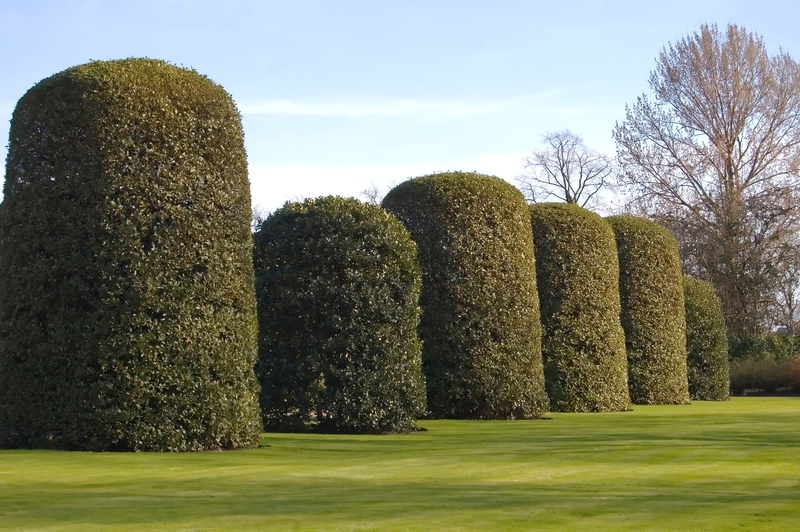Conquer Unwanted Growth: 3 Tips for Effective Weed Management
Posted on 01/07/2025
Conquer Unwanted Growth: 3 Tips for Effective Weed Management
Unwanted plant growth can quickly overrun gardens, landscapes, and agricultural fields, robbing your beautiful spaces and valuable crops of nutrients, light, and water. Finding reliable ways to manage and conquer these unwelcome intruders is essential for maintaining healthy, thriving landscapes. Whether you are a home gardener, lawn enthusiast, or professional landscaper, understanding effective weed management is crucial.
This comprehensive guide will walk you through three powerful tips to control weeds effectively and reclaim your space from unwanted growth. Get ready to discover practical, science-backed weed suppression methods--from cultural practices to eco-friendly solutions--that will transform your weed management strategy for good!
Why Is Weed Management Important?
Before diving into the top tips for weed control, it's important to understand why tackling unwanted plant growth matters:
- Weeds compete for resources: They steal water, sunlight, and nutrients from valuable plants, ultimately reducing crop yields and garden growth.
- Spread of pests and diseases: Many weeds serve as hosts for harmful pests and diseases that can further harm your plants.
- Reduced aesthetic value: A weed-infested lawn or garden simply looks unkempt, which reduces your property's curb appeal.
- Environmental impact: Invasive weeds can upset local ecosystems and crowd out native species, threatening biodiversity.
Recognizing the importance of weed management strategies is the first step toward conquering stubborn growth. Now, let's focus on the three best tips to keep your gardens and landscapes weed-free.

1. Embrace Preventive Methods: Stop Weeds Before They Start
Understanding Prevention in Weed Management
Proactive, preventive measures are the backbone of effective weed control. By creating conditions unfavorable for weeds, you make it less likely for them to establish themselves in the first place. Here are the must-know prevention techniques:
Mulching: Nature's Barrier
Mulching is one of the simplest yet most effective ways to suppress unwanted plant growth.
- Organic mulches (like wood chips, straw, or compost) smother soil, blocking sunlight and physically preventing weed seeds from germinating.
- Inorganic mulches (like landscape fabric or gravel) provide longer-lasting weed barriers for more established landscapes.
- Bonus: Mulches improve soil moisture retention and temperature regulation, benefitting your desirable plants.
Proper Spacing & Dense Planting
Weeds thrive in empty patches and open spaces. To minimize weed opportunity:
- Plan your garden design to use tightly spaced plants, groundcovers, and dense planting beds, reducing open soil available for weeds to take root.
- Choose fast-growing cover crops in vegetable gardens during off-seasons to suppress weed growth and improve soil health.
Healthy Soil, Healthy Plants
Vigorous, healthy plants overshadow and out-compete weeds:
- Maintain proper soil fertility and pH--test your soil regularly and amend it as needed to support strong root systems.
- Water wisely: direct irrigation to desirable plants and avoid overwatering, which encourages weed seed sprouting in bare soil.
2. Physical & Mechanical Weed Removal: Eliminate Weeds by Hand and Tool
Hand Pulling: Old-Fashioned but Effective
While manual removal can be labor-intensive, it offers precision and immediate impact. Especially useful for small gardens, flower beds, or areas with young weeds:
- Pull weeds when soil is moist, grabbing them close to the base and removing the entire root system.
- Dispose of weeds away from the garden to prevent re-seeding and regrowth.
- Tip: Use gloves and specialized weeding tools for comfort and efficiency.
Cultivation and Hoeing
Shallow cultivation with hoes or hand cultivators disrupts young weeds at the seedling stage:
- Cultivate during dry weather, as dislodged weeds are less likely to re-root.
- Avoid deep tilling, which can bring buried weed seeds to the surface, leading to more unwanted growth.
Flame Weeding and Solarization
For persistent weeds or large areas, consider non-chemical, focused methods:
- Flame weeding: Pass a flame weeder over weeds quickly to burst plant cells and kill above-ground growth (best for driveways, walkways, and non-flammable areas).
- Soil Solarization: Cover soil with clear plastic during peak sun to heat and kill weed seeds, roots, and pathogens. This is especially useful before planting new gardens or vegetable beds.
Regular Maintenance Is Key
Set a routine schedule for weed checks and removal. Early, frequent attention prevents weeds from maturing and seeding, reducing future infestations. The best weed management isn't a one-time event, it's an ongoing process!
3. Judicious Use of Chemical and Organic Herbicides: Kill Weeds Responsibly
Understanding Herbicide Types
Integrated weed management sometimes calls for herbicides--either organic or synthetic. Use these products cautiously and as a supplement to preventive and physical control. Herbicides fall into two main categories:
- Pre-emergent Herbicides: Applied before weed seeds germinate, forming a barrier that prevents growth (ideal for established lawns or paths).
- Post-emergent Herbicides: Target growing weeds by attacking leaves or roots (suited for spot-treating specific invaders).
Organic Herbicide Options
- Products containing natural acids (e.g., acetic acid, citric acid, or clove oil) can be effective against young annual weeds.
- Boiling water, vinegar, or even select homemade weed sprays offer eco-friendly solutions for small infestations.
Best Practices for Safe, Effective Use
- Always read and follow label instructions for dosage, timing, and safety precautions.
- Avoid drift by applying herbicides on calm days and target only the intended weeds to protect wanted plants.
- Rotate herbicide types to prevent the development of resistant weed populations.
- Wear gloves, masks, and protective clothing as recommended.
Integrated Weed Management (IWM): The Holistic Approach
Combining preventive, mechanical, and chemical methods--known as Integrated Weed Management--delivers long-lasting control while minimizing environmental impact. IWM tailors weed control to your specific landscape, crop, and weed pressures, making it the most sustainable solution for conquering unwanted growth.
Bonus: Additional Pro Tips for Weed Suppression
- Pull weeds before they flower and set seed, breaking the weed life cycle and preventing future infestations.
- Identify and target problem weeds: Learn to recognize the top invaders in your region (crabgrass, bindweed, dandelion, chickweed, etc.), and adapt your control methods accordingly.
- Encourage beneficial insects and natural predators that feed on weed seeds and help manage unwanted plants naturally.
- Regularly inspect and clean garden tools, mowers, and equipment to avoid spreading weed seeds between beds, lawns, or fields.
What to Avoid When Managing Weeds
- Don't ignore early signs: Neglecting young weeds can result in widespread problems.
- Don't over-till: Excessive digging or turning the soil can bring new weed seeds to the surface.
- Don't rely solely on herbicides: Chemicals alone are rarely a long-term solution and can cause resistance or environmental harm.
- Don't compost problem weeds: Weeds with seeds or persistent roots can regrow from your compost pile unless it reaches high temperatures.

Frequently Asked Questions (FAQ) About Weed Management
1. What is the best time to control weeds?
Early spring and late summer are ideal, as you target weeds before they mature and drop seeds. Always remove weeds when you spot them, regardless of the season!
2. Are there any low-maintenance landscaping options to reduce weeds?
Yes! Consider using ground covers, perennial beds, xeriscaping (drought-tolerant plants), and extensive mulching as part of your weed prevention plan.
3. Can I use household products for weed control?
Household products like vinegar or boiling water can work for small, isolated weeds on patios, paths, or driveways. Always test on a small area first to avoid accidental damage to desirable plants.
Conclusion: Take Control and Conquer Unwanted Weeds
Integrated, effective weed management doesn't have to be overwhelming. By embracing preventive cultural methods, diligent physical removal, and responsible herbicide use, you can conquer unwanted growth in any garden, lawn, or landscape. Remember:
- Start with smart prevention.
- Stay diligent with regular removal.
- Use targeted products only when necessary.
Your efforts today will pay off in healthier, more vibrant green spaces tomorrow. Whether your goal is a perfect golf-course lawn or a productive backyard garden, consistent application of these weed control tips will help you conquer unwanted growth for good.
Ready to transform your landscape? Commit to these actionable weed management strategies and enjoy a flourishing, weed-free environment season after season!

